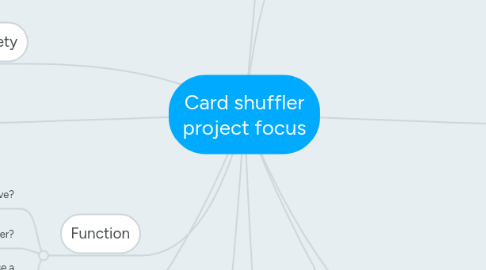
1. Consumer
1.1. How much will they pay for the product?
1.2. What appeals to the buyer/user?
1.3. Who will be the main target audience?
2. Environment
2.1. Where will the product be used?
2.1.1. Inside
2.1.1.1. Can be battery powered but probably mains powered
2.1.1.2. No need for waterproof materials
2.1.2. Outside
2.1.2.1. Needs to be portable
2.1.2.1.1. Needs to be battery powered
2.1.2.1.2. Needs to be lightweight
2.1.2.2. Needs to be waterproof and resistant
3. Safety
3.1. How will the product be safe for anyone to use?
3.1.1. No sharp edges
3.1.2. No non-insulated electric wires
3.1.3. Needs to have the input somewhere suitable
4. Size
4.1. How big will it have to be hold all the electronics?
4.2. Can't be too big as it will drive up the cost
4.3. How big is an average deck of cards?
4.4. How big will the product have to be to fit all sizes of decks?
5. Function
5.1. What parts will move?
5.1.1. How will they move? (Up, down/ around)?
5.2. how will it interact with the user?
5.3. How will the product completely randomise a deck of cards?
6. Materials
6.1. Woods
6.1.1. Softwoods
6.1.1.1. Pine?
6.1.1.2. Ash?
6.1.1.3. Beech?
6.1.2. Hardwoods
6.1.2.1. Oak?
6.1.2.2. Maple?
6.1.2.3. Cherry?
6.1.3. Man-made woods
6.1.3.1. Plywood?
6.1.3.2. Chipboard?
6.1.3.3. MDF?
6.2. Metals
6.2.1. Ferrous
6.2.1.1. Carbon steel?
6.2.1.2. Cast iron?
6.2.2. Non-ferrous
6.2.2.1. Aluminium?
6.2.2.2. Copper?
6.3. Plastics
6.3.1. Polypropylene?
6.3.2. Polystyrene?
6.4. The materials used will depend on the environment and manufacture processes available
7. Context
7.1. Needs to have moving parts
7.2. Needs to be able to shuffle a deck of cards
7.3. Needs to be accessible to a wide variety of people
7.4. How will the product ensure that the deck is properly shuffled and fast in doing so?
8. Aesthetics
8.1. What colours would appeal to a wide variety of people?
8.2. A good finish on the product can make it more appealing for the user
8.3. Interview consumer about design choices
8.4. How could the design link in with the idea of cards?
9. Cost
9.1. Ways to keep costs down
9.1.1. Use cheaper, reliable materials
9.1.2. Use cheap manufacture methods
9.1.3. Create the product in batches
9.1.4. Don't make the project too big so it is cheaper to make
9.1.5. Don't over complicate the circuit so that less components need to be bought
9.2. How much would people be willing to pay for this product?
9.2.1. Interview people and see what price the product should be
9.2.2. Investigate similar products on the market and see if there are any patterns in the prices.
10. Components
10.1. Input
10.1.1. PTM switch
10.1.2. Motion sensor
10.1.3. Pressure pad
10.1.4. LDR
10.2. Process
10.2.1. Microprocessor
10.3. Output
10.3.1. Light
10.3.1.1. LED
10.3.1.2. Bulb
10.3.1.3. LED strip
10.3.1.4. Seven-segment display
10.3.1.5. LCD
10.3.2. Movement
10.3.2.1. Motors
10.3.2.1.1. DC motor
10.3.2.1.2. DC Servo motor
10.3.2.1.3. Stepper motor
10.3.2.2. Solenoid
10.3.2.3. Pnuematics
11. Manufacturing methods
11.1. How can manufacturing methods be kept down?
11.1.1. Mass production?
11.1.2. Batch production?
11.1.3. Cheap materials and methods?
11.2. Processes
11.2.1. 3D printing?
11.2.2. Vacuum forming?
11.2.3. Injection moulding?
11.2.4. Laser cutting?
11.2.5. Casting?
11.2.6. Wielding?
11.2.7. Soldering?
